Abstract
A behavior-analytic critique of self-efficacy theory is presented. Self-efficacy theory asserts that efficacy expectations determine approach behavior and physiological arousal of phobics as well as numerous other clinically important behaviors. Evidence which is purported to support this assertion is reviewed. The evidence consists of correlations between self-efficacy ratings and other behaviors. Such response-response relationships do not unequivocally establish that one response causes another. A behavior-analytic alternative to self-efficacy theory explains these relationships in terms of environmental events. Correlations between self-efficacy rating behavior and other behavior may be due to the contingencies of reinforcement that establish a correspondence between such verbal predictions and the behavior to which they refer. Such a behavior-analytic account does not deny any of the empirical relationships presented in support of self-efficacy theory, but it points to environmental variables that could account for those relationships and that could be manipulated in the interest of developing more effective treatment procedures.
Keywords: Self-efficacy expectations, correspondence, behavior analysis, rule-governed behavior, phobias, private events
Full text
PDF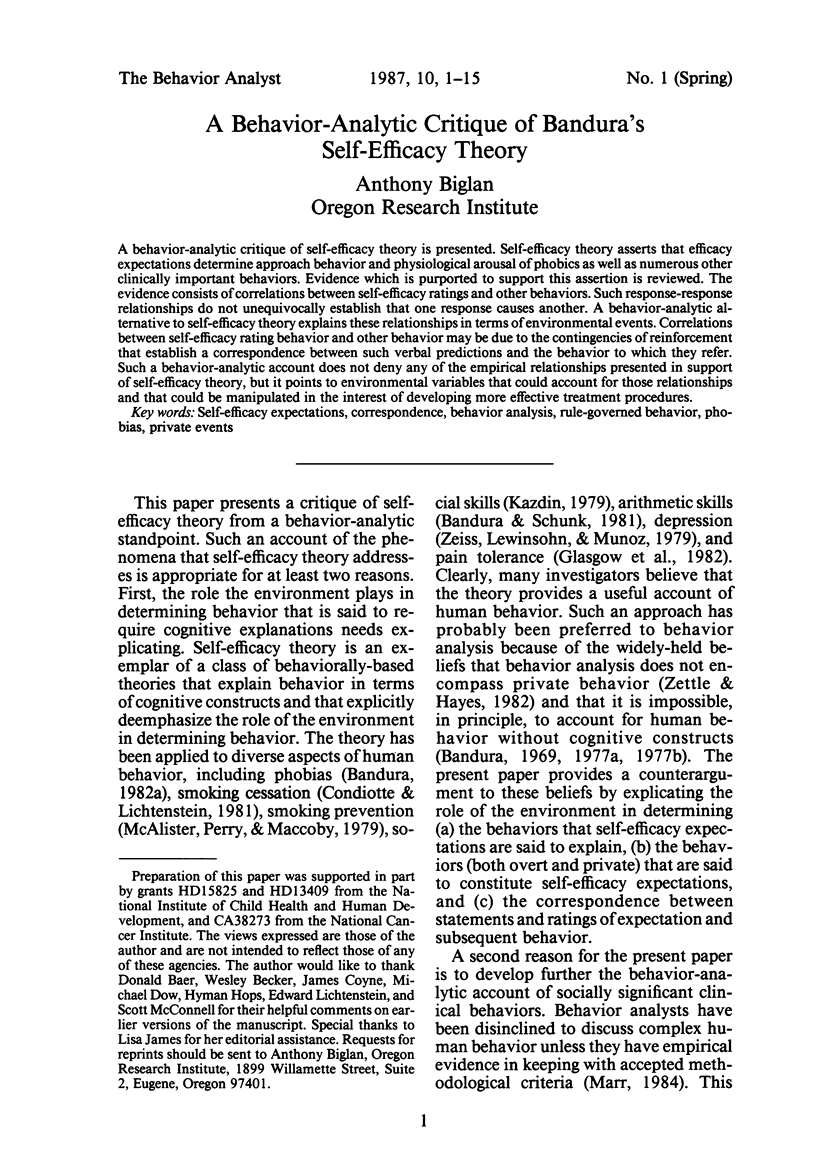
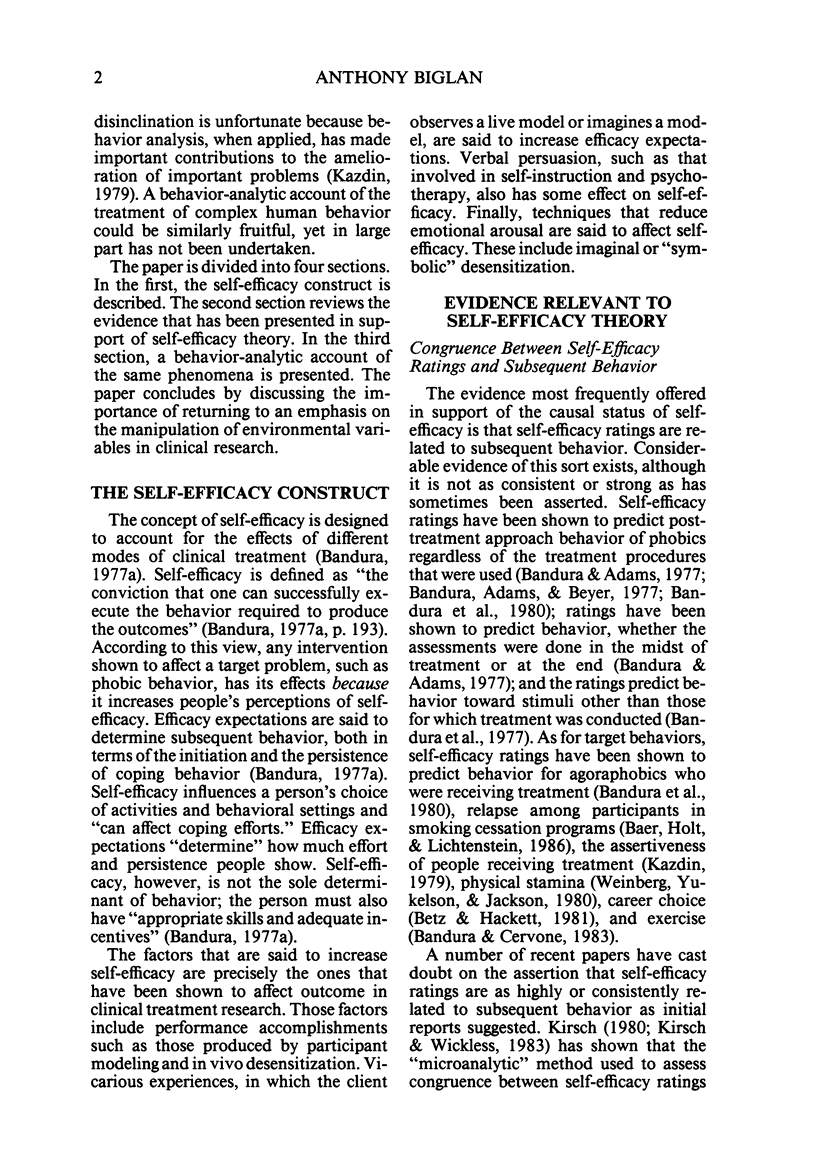
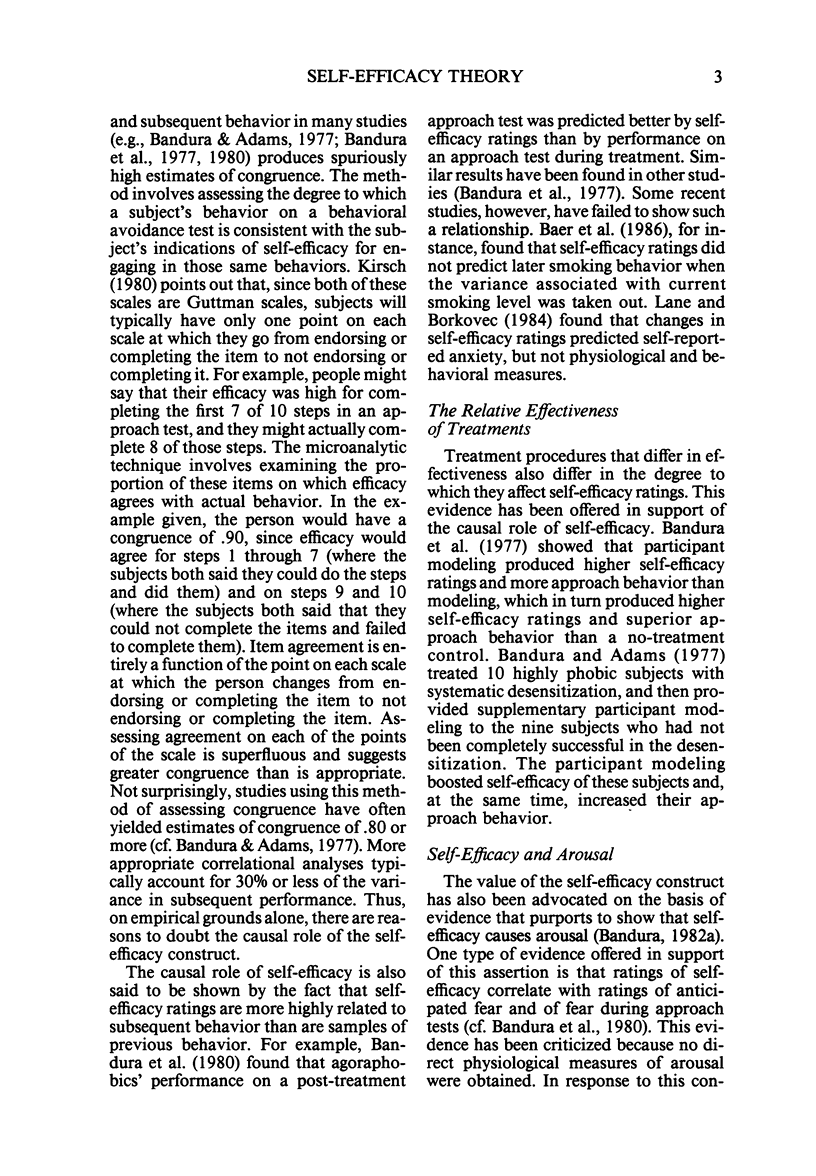
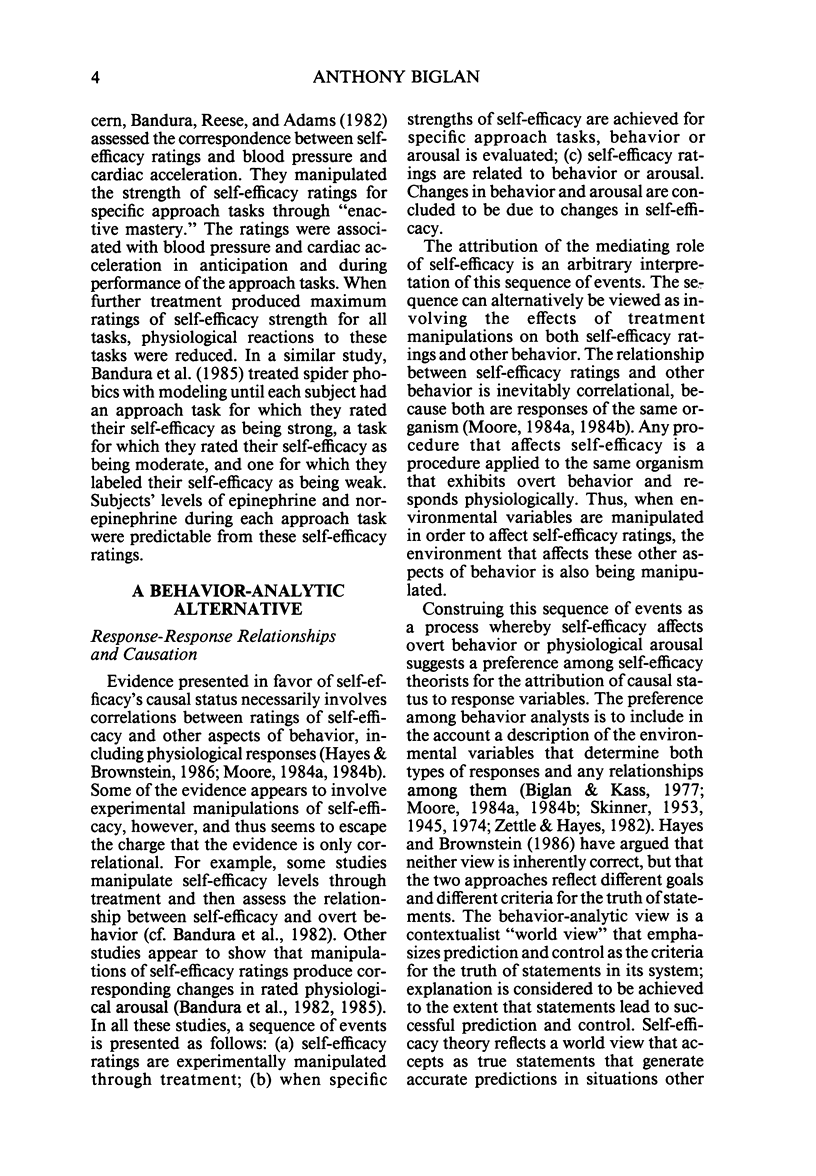

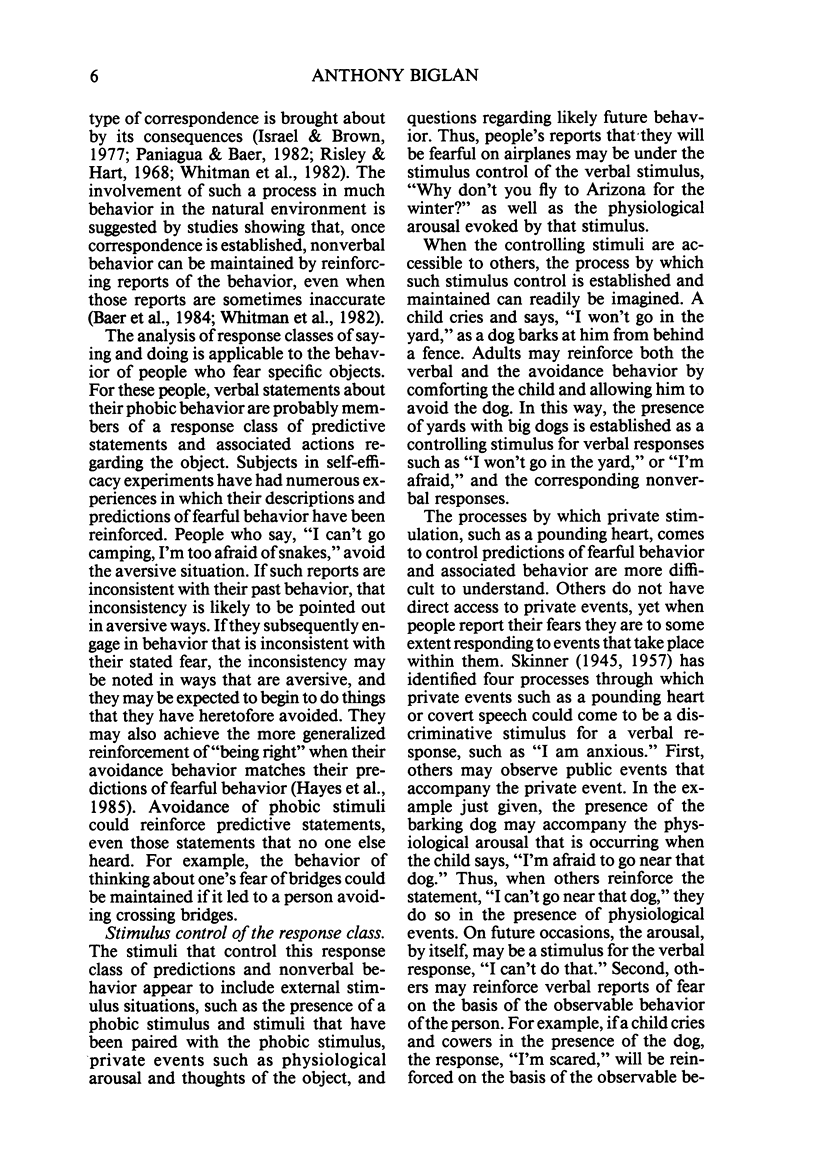
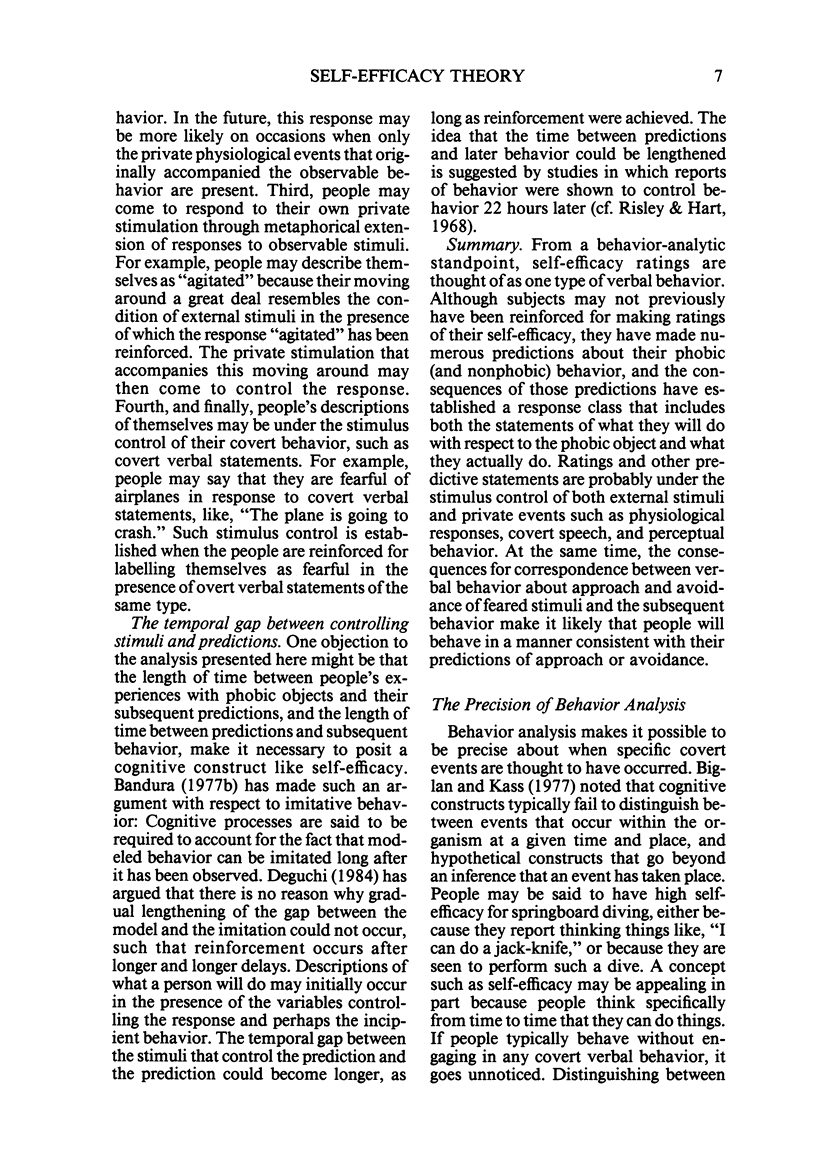
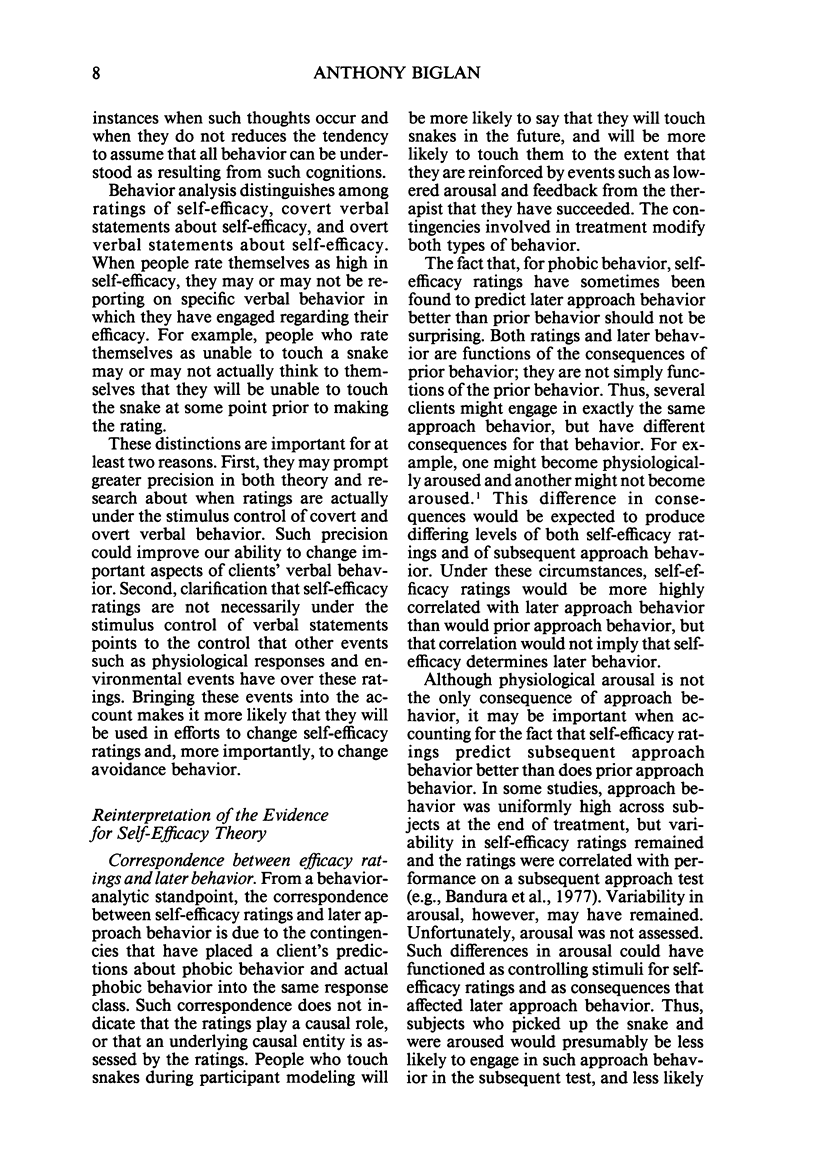

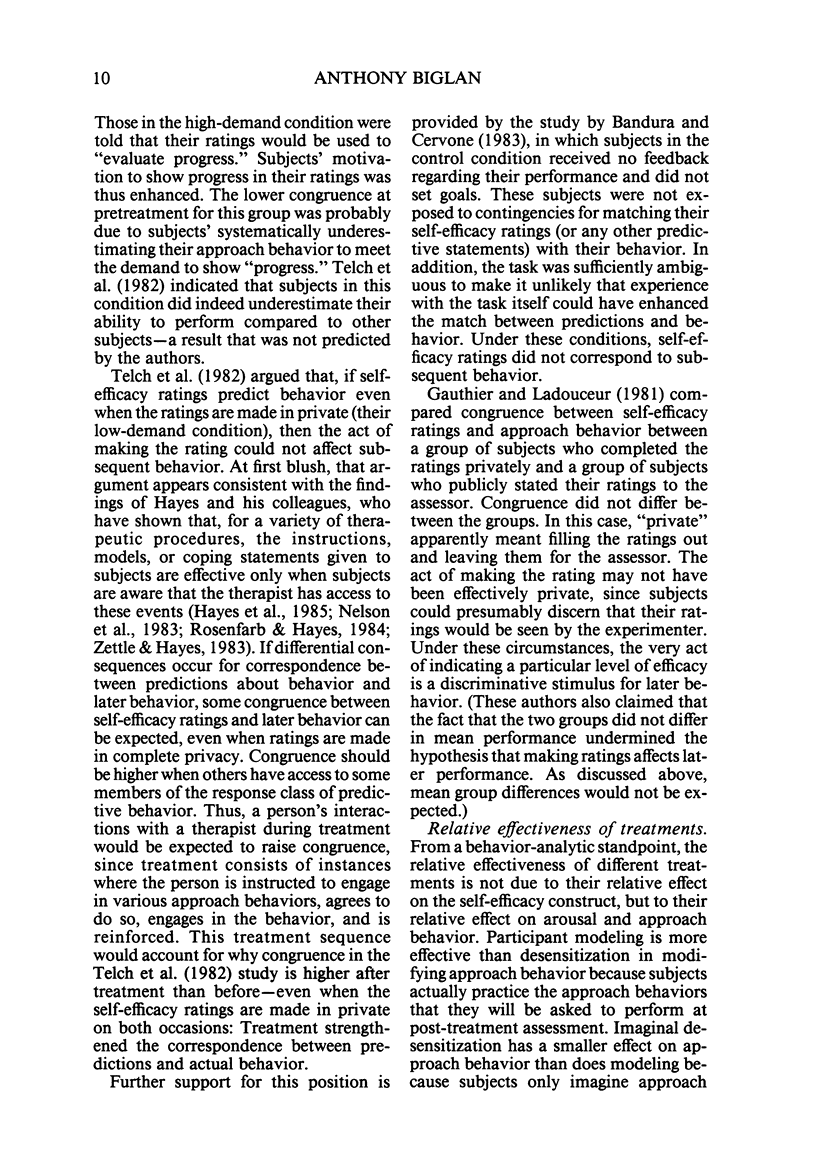
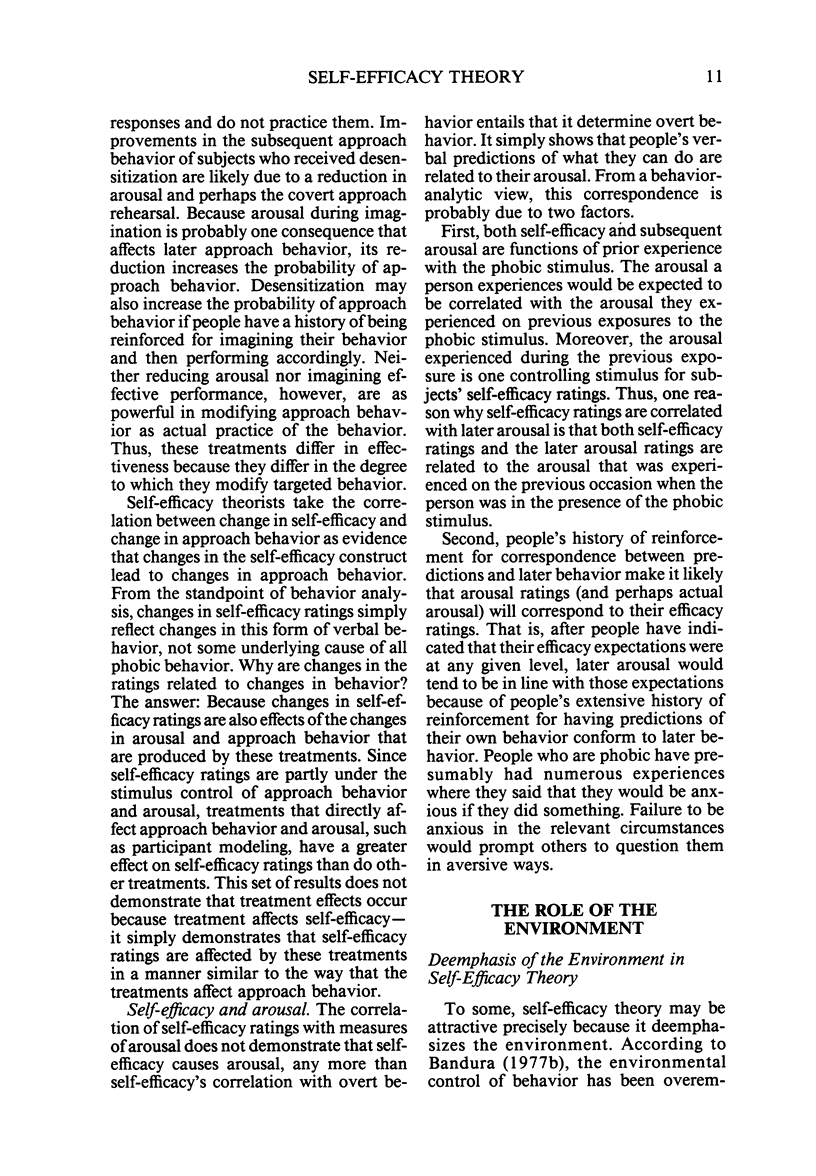
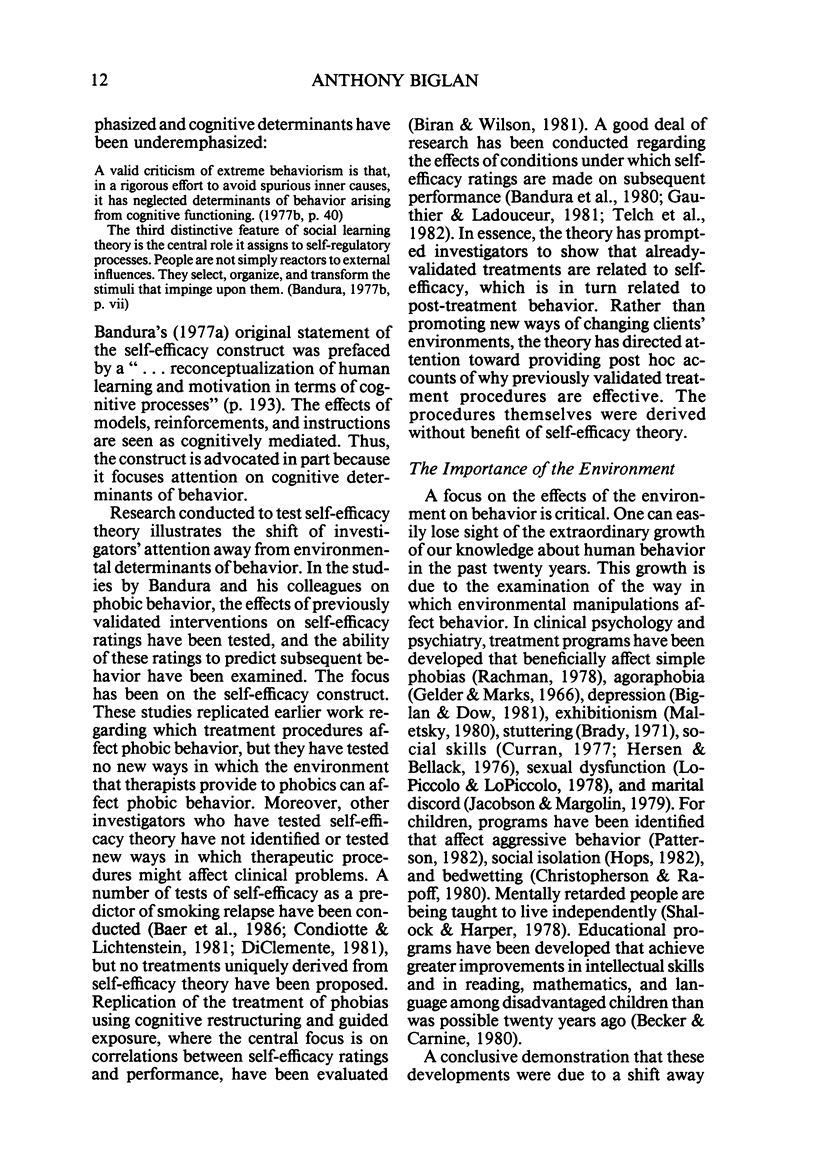
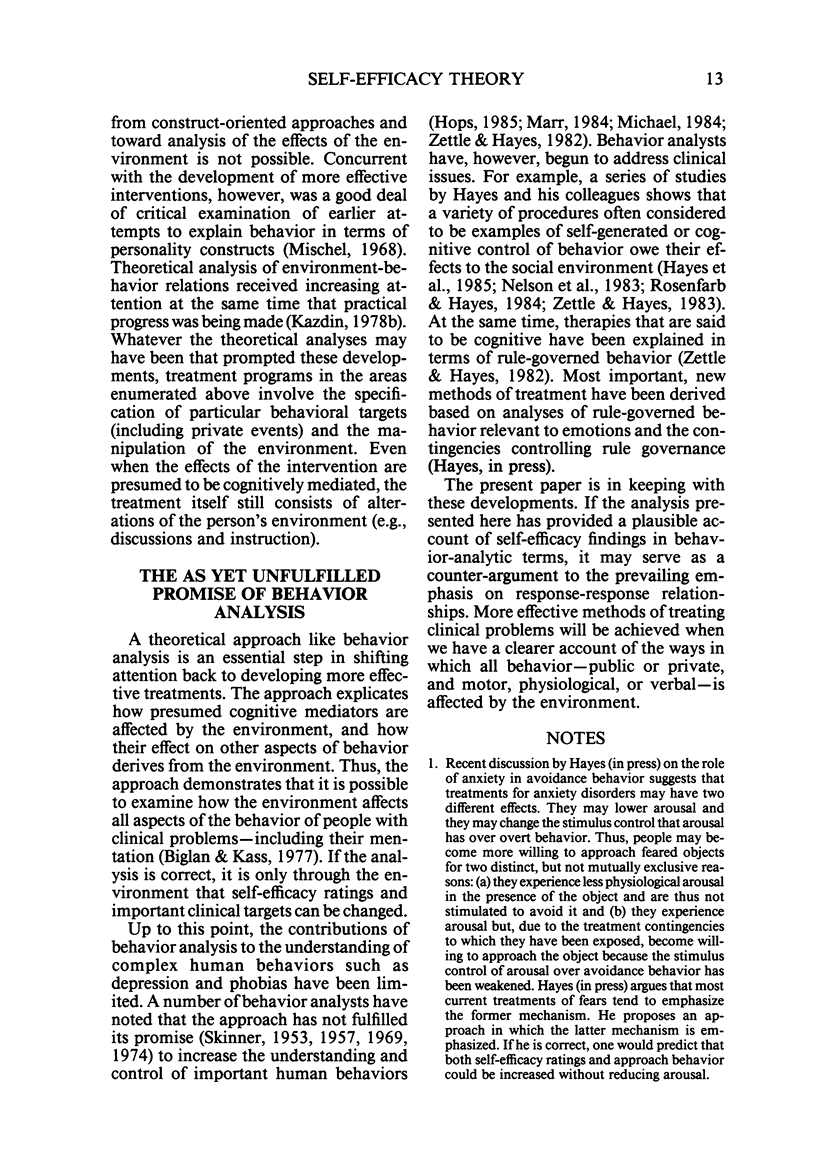

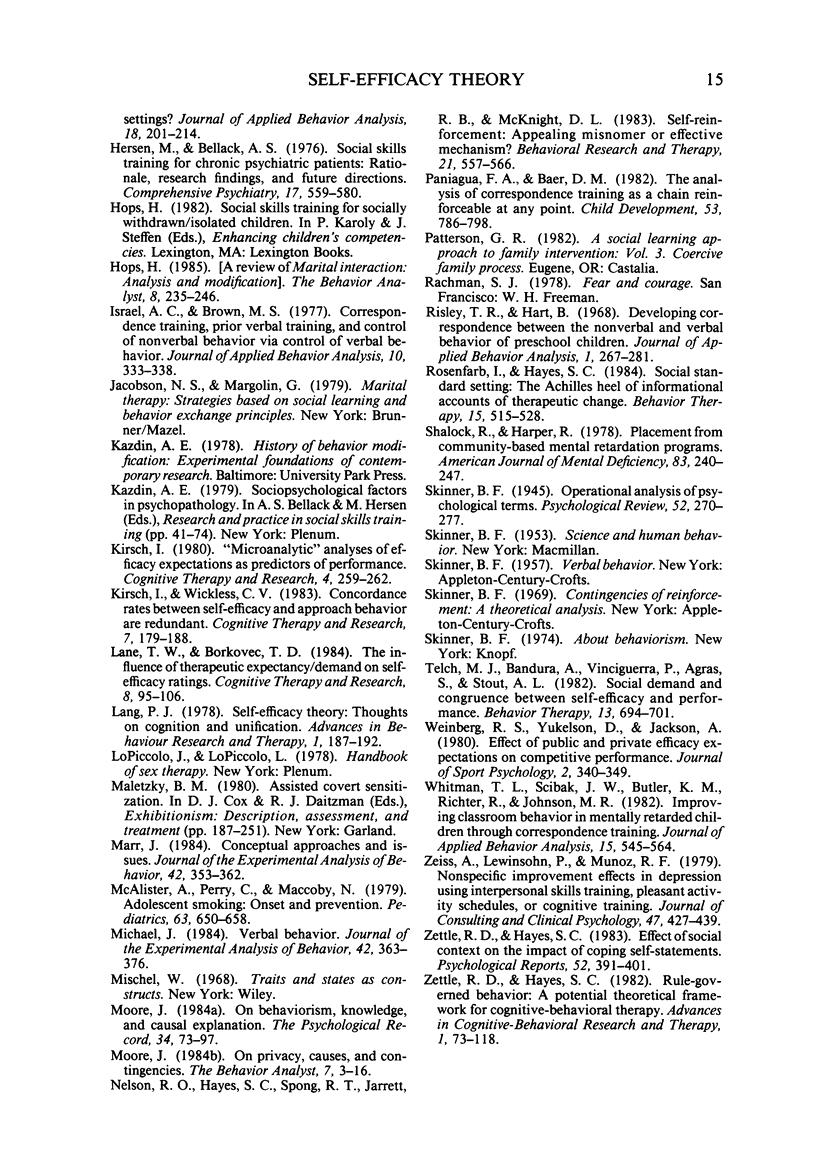
Selected References
These references are in PubMed. This may not be the complete list of references from this article.
- Baer J. S., Holt C. S., Lichtenstein E. Self-efficacy and smoking reexamined: construct validity and clinical utility. J Consult Clin Psychol. 1986 Dec;54(6):846–852. doi: 10.1037//0022-006x.54.6.846. [DOI] [PubMed] [Google Scholar]
- Baer R. A., Williams J. A., Osnes P. G., Stokes T. F. Delayed reinforcement as an indiscriminable contingency in verbal/nonverbal correspondence training. J Appl Behav Anal. 1984 Winter;17(4):429–440. doi: 10.1901/jaba.1984.17-429. [DOI] [PMC free article] [PubMed] [Google Scholar]
- Bandura A., Adams N. E., Beyer J. Cognitive processes mediating behavioral change. J Pers Soc Psychol. 1977 Mar;35(3):125–139. doi: 10.1037//0022-3514.35.3.125. [DOI] [PubMed] [Google Scholar]
- Bandura A., Reese L., Adams N. E. Microanalysis of action and fear arousal as a function of differential levels of perceived self-efficacy. J Pers Soc Psychol. 1982 Jul;43(1):5–21. doi: 10.1037//0022-3514.43.1.5. [DOI] [PubMed] [Google Scholar]
- Bandura A. Self-efficacy: toward a unifying theory of behavioral change. Psychol Rev. 1977 Mar;84(2):191–215. doi: 10.1037//0033-295x.84.2.191. [DOI] [PubMed] [Google Scholar]
- Bandura A., Taylor C. B., Williams S. L., Mefford I. N., Barchas J. D. Catecholamine secretion as a function of perceived coping self-efficacy. J Consult Clin Psychol. 1985 Jun;53(3):406–414. doi: 10.1037//0022-006x.53.3.406. [DOI] [PubMed] [Google Scholar]
- Bandura A. The assessment and predictive generality of self-percepts of efficacy. J Behav Ther Exp Psychiatry. 1982 Sep;13(3):195–199. doi: 10.1016/0005-7916(82)90004-0. [DOI] [PubMed] [Google Scholar]
- Biran M., Wilson G. T. Treatment of phobic disorders using cognitive and exposure methods: a self-efficacy analysis. J Consult Clin Psychol. 1981 Dec;49(6):886–899. doi: 10.1037//0022-006x.49.6.886. [DOI] [PubMed] [Google Scholar]
- Condiotte M. M., Lichtenstein E. Self-efficacy and relapse in smoking cessation programs. J Consult Clin Psychol. 1981 Oct;49(5):648–658. doi: 10.1037//0022-006x.49.5.648. [DOI] [PubMed] [Google Scholar]
- Curran J. P. Skills training as an approach to the treatment of heterosexual-social anxiety: a review. Psychol Bull. 1977 Jan;84(1):140–157. [PubMed] [Google Scholar]
- Deguchi H. Observational learning from a radical-behavioristic viewpoint. Behav Anal. 1984 Fall;7(2):83–95. doi: 10.1007/BF03391892. [DOI] [PMC free article] [PubMed] [Google Scholar]
- Gelder M. G., Marks I. M. Severe agoraphobia: a controlled prospective trial of behaviour therapy. Br J Psychiatry. 1966 Mar;112(484):309–319. doi: 10.1192/bjp.112.484.309. [DOI] [PubMed] [Google Scholar]
- Hayes S. C., Brownstein A. J. Mentalism, behavior-behavior relations, and a behavior-analytic view of the purposes of science. Behav Anal. 1986 Fall;9(2):175–190. doi: 10.1007/BF03391944. [DOI] [PMC free article] [PubMed] [Google Scholar]
- Hayes S. C., Brownstein A. J., Zettle R. D., Rosenfarb I., Korn Z. Rule-governed behavior and sensitivity to changing consequences of responding. J Exp Anal Behav. 1986 May;45(3):237–256. doi: 10.1901/jeab.1986.45-237. [DOI] [PMC free article] [PubMed] [Google Scholar]
- Hayes S. C., Rosenfarb I., Wulfert E., Munt E. D., Korn Z., Zettle R. D. Self-reinforcement effects: An artifact of social standard setting? J Appl Behav Anal. 1985 Fall;18(3):201–214. doi: 10.1901/jaba.1985.18-201. [DOI] [PMC free article] [PubMed] [Google Scholar]
- Hersen M., Bellack A. S. Social skills training for chronic psychiatric patients: rationale, research findings, and future directions. Compr Psychiatry. 1976 Jul-Aug;17(4):559–580. doi: 10.1016/0010-440x(76)90038-9. [DOI] [PubMed] [Google Scholar]
- Israel A. C., Brown M. S. Correspondence training, prior verbal training, and control of nonverbal behavior via control of verbal behavior. J Appl Behav Anal. 1977 Summer;10(2):333–338. doi: 10.1901/jaba.1977.10-333. [DOI] [PMC free article] [PubMed] [Google Scholar]
- Marr M. J. Conceptual approaches and issues. J Exp Anal Behav. 1984 Nov;42(3):353–362. doi: 10.1901/jeab.1984.42-353. [DOI] [PMC free article] [PubMed] [Google Scholar]
- McAlister A. L., Perry C., Maccoby N. Adolescent smoking: onset and prevention. Pediatrics. 1979 Apr;63(4):650–658. [PubMed] [Google Scholar]
- Michael J. Verbal behavior. J Exp Anal Behav. 1984 Nov;42(3):363–376. doi: 10.1901/jeab.1984.42-363. [DOI] [PMC free article] [PubMed] [Google Scholar]
- Moore J. On privacy, causes, and contingencies. Behav Anal. 1984 Spring;7(1):3–16. doi: 10.1007/BF03391881. [DOI] [PMC free article] [PubMed] [Google Scholar]
- Nelson R. O., Hayes S. C., Spong R. T., Jarrett R. B., McKnight D. L. Self-reinforcement: appealing misnomer or effective mechanism? Behav Res Ther. 1983;21(5):557–566. doi: 10.1016/0005-7967(83)90047-5. [DOI] [PubMed] [Google Scholar]
- Risley T. R., Hart B. Developing correspondence between the non-verbal and verbal behavior of preschool children. J Appl Behav Anal. 1968 Winter;1(4):267–281. doi: 10.1901/jaba.1968.1-267. [DOI] [PMC free article] [PubMed] [Google Scholar]
- Schalock R. L., Harper R. S. Placement from community-based mental retardation programs: how well do clients do? Am J Ment Defic. 1978 Nov;83(3):240–247. [PubMed] [Google Scholar]
- Whitman T. L., Scibak J. W., Butler K. M., Richter R., Johnson M. R. Improving classroom behavior in mentally retarded children through correspondence training. J Appl Behav Anal. 1982 Winter;15(4):545–564. doi: 10.1901/jaba.1982.15-545. [DOI] [PMC free article] [PubMed] [Google Scholar]
- Zeiss A. M., Lewinsohn P. M., Muñoz R. F. Nonspecific improvement effects in depression using interpersonal skills training, pleasant activity schedules, or cognitive training. J Consult Clin Psychol. 1979 Jun;47(3):427–439. doi: 10.1037//0022-006x.47.3.427. [DOI] [PubMed] [Google Scholar]
- Zettle R. D., Hayes S. C. Effect of social context on the impact of coping self-statements. Psychol Rep. 1983 Apr;52(2):391–401. doi: 10.2466/pr0.1983.52.2.391. [DOI] [PubMed] [Google Scholar]


